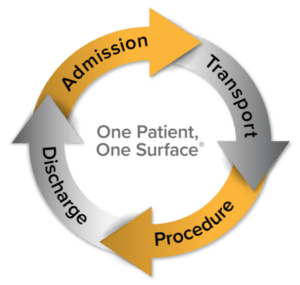
Surgical Trends in the ER
The landscape of emergency room (ER) surgeries is continuously evolving, and the trends we’ve seen in 2024 reflect significant technological advancements, shifting healthcare priorities, and a growing emphasis on efficiency.
Emergency surgeries are critical, requiring precision, speed, and coordination to address a variety of urgent medical conditions. These new trends are transforming how healthcare professionals manage surgical interventions, optimizing outcomes for patients, and enhancing overall care delivery.
Below, we explore the most notable surgical trends in the ER from 2024 and those anticipated to continue in 2025.
![]()
What Are Robotic-Assisted Surgeries?
One of the most prominent trends in ER surgeries is the increasing use of robotic-assisted technologies. The integration of robotic systems into emergency procedures enables surgeons to perform complex surgeries with greater precision, minimal invasiveness, and improved control. These systems often allow for smaller incisions, which leads to faster patient recovery, reduced hospital stays, and fewer complications.
Sign up to get the latest industry news and offers right in your inbox
Robotic surgery is expected to become more commonplace in emergency settings, especially in trauma cases and surgeries requiring extreme precision, such as abdominal or thoracic operations. The trend toward robotic-assisted surgeries also aligns with the broader push for minimally invasive procedures, which reduce patient trauma and recovery times.
![]()
Telemedicine and Remote Surgery
Telemedicine has grown rapidly in the last few years, but its applications in emergency surgery are just beginning to take shape. Surgeons and emergency teams are now able to consult specialists remotely during complex surgical procedures, thanks to high-definition video conferencing and real-time data sharing. This trend is proving invaluable, especially in rural or under-resourced hospitals where access to certain surgical expertise may be limited.
Read More: “What to Do and NOT Do in the Surgical Environment”
Looking ahead to 2025, remote surgeries, where surgeons guide robotic systems from afar, are becoming more feasible with advancements in 5G connectivity and precision instruments. In cases of extreme urgency or when a highly specialized surgeon is required, remote surgery allows patients to receive immediate care, without the need to transfer them to a larger facility. This approach also opens up new opportunities for global collaboration in emergency surgery, further expanding the reach of top-tier medical care.
![]()
Artificial Intelligence (AI) in Emergency Surgery
AI is transforming many aspects of healthcare, and emergency surgery is no exception. AI is being used to assist in decision-making during critical moments, analyzing data from patient histories, current vitals, and imaging scans to provide recommendations on the best surgical approaches. AI-driven tools are becoming more prevalent in the ER, assisting surgeons in real-time during procedures.
One area where AI is making a significant impact is in predictive analytics. For instance, AI can rapidly analyze a patient’s risk factors and predict potential complications that may arise during surgery, allowing teams to adjust their strategies accordingly. Additionally, AI is enhancing imaging technologies, providing more accurate and detailed insights into patients’ conditions, particularly in cases of internal bleeding or organ damage. As AI continues to evolve, its role in assisting with diagnostics, surgical planning, and even real-time decision-making will become more prominent.
Read More: “The Top 10 Reasons People Go to the ER”
3D Printing for Custom Surgical Tools and Implants
3D printing technology is increasingly finding its place in emergency surgeries, particularly when there is a need for customized surgical tools or implants. In trauma cases, where bones or organs may be severely damaged, 3D printing allows surgeons to create patient-specific models and prosthetics on demand. This capability is especially useful when dealing with complex fractures or reconstructive surgeries that require tailored solutions.
We expect to see more emergency departments equipped with 3D printing capabilities, enabling faster responses to complicated surgical cases. The ability to print custom implants or surgical guides in real-time allows for better surgical outcomes, reduces the chances of post-operative complications, and shortens recovery times.
![]()
Personalized Medicine and Genomics in Surgery
Emergency room surgeries are often performed under immense time pressure, which makes immediate and accurate diagnostics critical. Point-of-care diagnostic tools, including portable ultrasound devices and handheld imaging scanners, are streamlining the pre-surgery process. These technologies allow medical teams to quickly assess the extent of injuries, detect internal bleeding, and evaluate organ damage without the need for time-consuming, off-site diagnostics.
We can expect even more sophisticated portable imaging devices that integrate AI for faster interpretation and more precise diagnostics. These tools reduce the time between patient arrival and surgery, improving survival rates and outcomes. Moreover, advancements in imaging technologies will allow for real-time monitoring during surgeries, enabling surgeons to make informed decisions instantly and adapt their procedures on the fly.
![]()
Point-of-Care Diagnostics and Imaging
Personalized medicine is revolutionizing how healthcare providers approach treatment, and its influence is extending into emergency surgery. Using genomic data and individualized health profiles, surgeons are now able to tailor procedures to a patient’s unique biological makeup. This is particularly relevant in emergency surgeries involving cancer, where understanding the patient’s tumor genetics can guide immediate treatment decisions during procedures like tumor removal.
In the coming years, genomic data will be more routinely integrated into emergency settings, helping surgeons predict responses to anesthesia, potential complications, and recovery outcomes. Personalized approaches also mean that post-surgical care can be optimized, with medications and therapies tailored to each patient’s genetic profile, thus improving long-term recovery and reducing the risk of complications.
![]()
Enhanced ER Workflow With Wearable Technology
Wearable technology is playing a growing role in monitoring patients during emergency surgeries. Wearable devices can continuously track vital signs such as heart rate, oxygen levels, and blood pressure, providing surgeons with real-time data throughout the procedure. In emergency scenarios where patients may be unstable, these devices enable the surgical team to respond quickly to any sudden changes in a patient’s condition.
Wearable technology will become more sophisticated, offering advanced monitoring that can predict complications before they arise. These wearables, combined with AI and machine learning, could alert surgeons to potential issues, such as impending cardiac events or respiratory failure, allowing for preemptive interventions that could save lives.
![]()
How to Streamline the ER Workflow to Save Time, Money, and Lives
As these trends continue to develop, patients will benefit from faster recoveries, fewer complications, and better overall outcomes. The integration of technology into the ER is not just a glimpse of the future — it is actively reshaping the present, ensuring that emergency surgical care remains at the forefront of medical advancement.
Surgical units must optimize both their physical and logistical elements. To perform their best, surgeons and surgical nurses rely on various staff (who have particular protocols and systems in place) as well as various machines, while patients often show better outcomes when they feel informed and at ease throughout the process. Saving time can result in saving lives; it can also result in helping patients feel as supported and safe as possible.
Champion’s TMM Collection helps streamline flows and optimize physical space, allowing surgical staff to focus on patient care.

Our “One Patient, One Surface” philosophy is exemplified by our innovative procedure chairs, which convert easily from a comfortable wheelchair into a transport stretcher or medical seating used during surgical procedures.
To view our entire portfolio of products, browse our digital catalog. Then, request a quote for your facility.
